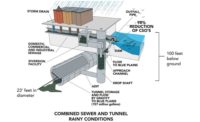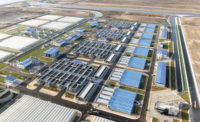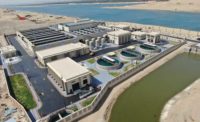Abu Hamour (Musaimeer) Surface and Groundwater Drainage Tunnel
Doha, Qatar
Best Project
Owner Public Works Authority, State of Qatar (ASHGHAL)
Lead Design Firm and Civil and Structural Engineer COWI A/S
Contractor Salini Impregilo SpA
Engineer Representative CDM Smith
A water project in Doha with big goals used an international team to bring about successful completion of a 9.5-kilometer water-collection tunnel. The Qatar Public Works Authority commissioned the first phase of the Abu Hamour, or Musaimeer, surface and groundwater drainage tunnel. The authority wanted to move groundwater and stormwater to the sea to decrease surface water and pumping costs for construction projects around the country and preserve building foundations by reducing subsidence.
The project is one of the country’s key efforts to upgrade its drainage network. Connecting to the existing network, the tunnel will drain about 170 sq km. Abu Hamour links to a pumping station with a capacity of 19 cu meters per second.
Abu Hamour was the first deep-tunnel project in Qatar. Salini Impregilo SpA served as the contractor for the $120-million project, which was designed and engineered by Denmark’s COWI A/S. Design firm CDM Smith served as project supervisor.
Salini Impreglio mobilized a specialized workforce from Italy, China and Pakistan, among other countries. Because this was Qatar’s first experience with such a project, Salini worked proactively to ensure local and international coordination and cooperation. The project, started in January 2013, was finished this past January with no lost-time incidents.
The tunnel, at a depth of 30 m, was excavated using two tunnel-boring machines, designed especially for the project and nicknamed “Al Thumama” and “Al Rawada” for the areas in which they operated. The machines were positioned at opposite ends of the tunnel and bored toward each other. Running underneath the area’s F-Ring road, the project was completed without any damage to the roadway or nearby buildings.
After the team experienced unexpected high water, 20 to 30 times greater than was anticipated during geotechnical investigations, Salini Impregilo had to build a temporary, 10-km dewatering network to the seashore to pump the water out of the construction site.
“It was decided to take advantage of the in-house know-how, developed in dam constructions, and mobilize crews and equipment to timely self-perform cement-chemical grout, to reduce the permeability of the ground and to reduce inflows of groundwater into the shaft to an acceptable level,” says Simone Centis, project manager for Salini Impregilo. The sequence of work was changed and resources were increased to accommodate the unforeseen grouting activity, without affecting the time for completion of the project, he says.
One major innovation was the elimination of membranes in the tunnel. While the contract called for a protective HDPE-and-epoxy membrane inside the precast-concrete segments, Salini Impregilo suggested omitting the membranes and, instead, investing more on the concrete itself.
Salini Impregilo, supported by Cowi A/S, proposed different concrete-mix designs and testing regimes, which made the membranes redundant and the overall structure more robust, Centis says, adding that Qatar and CDM “have been very open-minded and receptive to such innovation.”
At peak construction, the contractor had 393 people on site, with an additional 100 subcontractors.
Related Article: Global Best Projects Awards 2017








Post a comment to this article
Report Abusive Comment